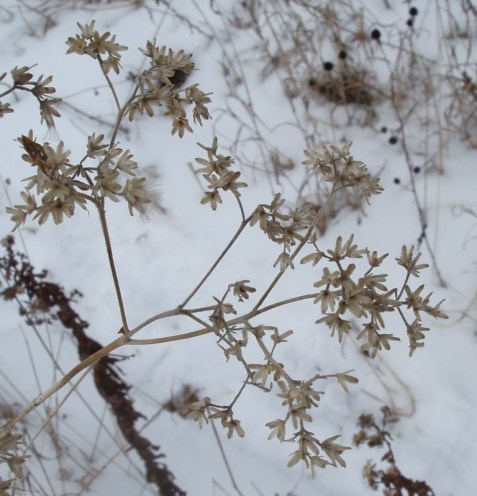by Carl Strang
It’s time to look at another Eupatorium in winter. This genus of herbaceous plants in the sunflower or aster family is relatively rich in our area, including the joe-pye weeds, white snakeroot, and a few species referred to as bonesets. Tall boneset can be found in savannas as well as prairies and meadows.

Here’s one in bloom. Most members of this genus have white flowers, though a few have pink or even blue ones.
In winter the calyces are relatively large, and persist for a while.
The leaves, with their few teeth concentrated in the ends, likewise hang on for a time.

It also remains clear that the leaves do not have distinct petioles, the blades narrowing down to where the leaf joins the stem.
I am especially struck by those large, few-lobed calyces that make this plant stand out in a winter botany array.

Oakmoss Education said,
January 31, 2014 at 5:04 pm
Oodles of Boneset grow in The Acre’s wet meadow, although it is being heavily competed with by invasive Purple Loosestrife, I’ve given up the eradication fight with Lythrum salicaria (see http://oakmossed.wordpress.com/2013/08/05/an-invader-wins/) except in a few small patches, including one where Boneset still has a strong foothold. It is far too valuable a medicinal to lose. The family has already made good use of its tincture in battling the flu this Winter. Thanks for highlighting an often overlooked (if not “despised as a weed”) important native.
natureinquiries said,
February 1, 2014 at 7:29 am
Thanks for your comment. From your description I am guessing that yours is the Eupatorium simply called “boneset,” E. perfoliatum. It is more of a wetland or wet meadow species than tall boneset, which grows in dry soils. For a while I used boneset leaf tea as an immune booster, but switched to purple coneflower roots which I could grow in the garden and tasted much better. For me, at least, it was equally effective. Though I just took some leaves, the wetland boneset is uncommon enough locally that I was not comfortable with slowing it down.